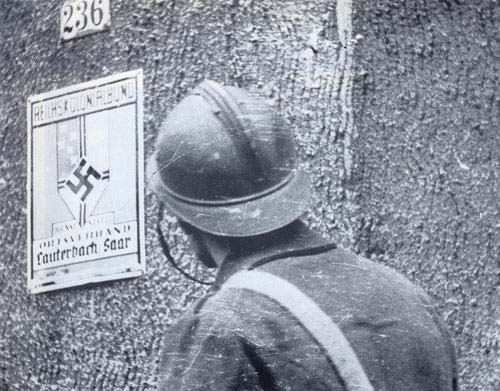| Saar Offensive | |||||||
|---|---|---|---|---|---|---|---|
|
|||||||
| Contenders | |||||||
| Military Leaders | |||||||
| Unit Strength | |||||||
| 40 Divisions 2400 tanks 4700 artillery |
22 Divisions less than 100 artillery |
||||||
| Casualties and Deaths | |||||||
| Total: | Total: | ||||||
| 2,000 dead, wounded and sick | 196 dead 114 missing 356 wounded 11 aircraft |
||||||
| Part of World War II | |||||||
The Saar Offensive is the name given to a French assault on western Germany during World War II from September 7–16, 1939. In September, 1939, German forces were largely concentrating on fighting and defeating Poland, which at that stage was still an active adversary. While they were so engaged, French soldiers made a somewhat hesitant advance on to German soil. The attack was not a success, and by the end of the month, the French forces had been withdrawn.
The Offensive Begins
On September 7, 1939, while the war was still in its first week, the General Staff of France decided to launch what they referred to as Operation Saar. Under the ultimate direction of Commander-in-Chief Louis Faury, the French Third, Fourth, and Fifth Armies crossed on to German soil. Maurice Gamelin was the general in direct command of the offensive, which saw a large number of mechanized infantry divisions cross the German border by September 9.
At first, French progress was relatively swift and smooth, with only very limited resistance being encountered. In a few sectors, minefields delayed the French troops’ advance – albeit for only a couple of days. One village is reported as having blocked the advance by use of a single machine gun, but this does seem to have been the exception rather than the rule. By September 12, the front line had pushed about five miles into Third Reich territory – but this proved to be the limit of the forward movement achieved by Gamelin’s men.
Once Germany had regrouped and reorganized its troops, they swiftly became too strong for the French armies to hold, and on September 21, General Gamelin was forced to order his soldiers to retreat. Despite some differences of opinion between Gamelin and his superior, Giraud, the French forces withdrew toward the Maginot Line, and by October 17, there were no such troops still stationed on German soil. The Saar Offensive had proved to be a nearly complete failure.
The German Reaction
By the beginning of October, 1939, Poland was effectively defeated, with most of its troops having already surrendered to the German army. This allowed Germany to transfer large numbers of men from the Eastern to the Western Front, in order to repulse the French invaders. Before long, German guns were able to pound forward positions near the Maginot Line itself, and planes of the Luftwaffe were able to operate with near-impunity, making France’s position almost impossible.
On October 16, Erwin von Witzleben, in command of the German first army, led a major action against the French forces. Although only a few square miles of territory were actively contested, it was a bitter and bloody battle, with almost 200 German soldiers losing their lives. This made it the most significant engagement on the Franco-German border during the early part of World War Two, not to be surpassed until Germany began its invasion of France in 1940.
Assessment
The failure of the Saar Offensive resulted in a lengthy period of stand-off, usually known as the Phoney War, in which there was little large-scale fighting in the region. Some authorities, including General Siegfried Westphal of Germany, have suggested that a more substantial push by the French invaders could have resulted in considerably more territorial gains – perhaps even extending as far as the heavily industrialized Ruhr valley region. The Offensive’s failure paved the way for France’s demoralization and eventual defeat over the following nine months.
